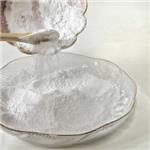1-Fluoronaphthalene: Overview, Biological Activities and Applications in Organic Solar Cells
Mar 1,2024
General Description
1-Fluoronaphthalene is a stable and non-reactive liquid compound with interesting biological activities. It has been found to be metabolized by C. elegans into several phenols and conjugates, and can be used to synthesize LY248686, a potent inhibitor of serotonin and noradrenaline uptake. Moreover, 1-fluoronaphthalene has great potential in improving the performance of organic solar cells as an additive. Recent studies show that it can fibrillate non-fullerene acceptors, improve their crystallization, and ultimately enhance the power conversion efficiency of organic solar cells. The use of 1-fluoronaphthalene in organic solar cells provides a valid way to achieve hierarchical morphology control and enhance device performance, which has significant implications for the development of organic solar cells.

Figure 1. 1-Fluoronaphthalene
Overview
1-Fluoronaphthalene is a liquid compound with a molecular formula of C10 H7 F and a molecular weight of 146.16. It appears as a light yellow liquid with no discernible odor. The physical properties of 1-Fluoronaphthalene include a melting point/range of -13 °C / 8.6 °F and a boiling point/range of 215 - 217 °C / 419 - 422.6 °F. It has a flash point of 65 °C / 149 °F and a specific gravity of 1.330. Under normal conditions, 1-Fluoronaphthalene is considered stable and non-reactive. It should be kept away from incompatible products, open flames, hot surfaces, and sources of ignition. Strong oxidizing agents are incompatible with this compound. In the event of decomposition, hazardous decomposition products such as carbon monoxide (CO), carbon dioxide (CO2), and gaseous hydrogen fluoride (HF) may be produced. However, no hazardous reactions are expected under normal processing conditions. Overall, 1-Fluoronaphthalene exhibits stability and low reactivity in typical environments. 1
Biological activities
1-Fluoronaphthalene is a derivative of naphthalene and fluorinated aromatics which has been found to have interesting biological activities. The metabolism of 1-fluoronaphthalene by Cunninghamella elegans ATCC 36112 has been studied and it was found that C. elegans oxidizes 1-fluoronaphthalene predominantly at the 3,4- and 5,6-positions to form trans-3,4-dihydroxy-3,4-dihydro-1-fluoronaphthalene and trans-5,6-dihydroxy-5,6-dihydro-1-fluoronaphthalene. In addition, several other metabolites were formed including 1-fluoro-8-hydroxy-5-tetralone, 5-hydroxy-1-fluoronaphthalene, and 4-hydroxy-1-fluoronaphthalene along with glucoside, sulfate, and glucuronic acid conjugates of these phenols. It was also found that the major enantiomers of the dihydrodiols formed from 1-fluoronaphthalene have S,S absolute stereochemistries. The results suggest that a fluoro substituent blocks epoxidation at the fluoro-substituted double bond, decreases oxidation at the aromatic double bond that is peri to the fluoro substituent, and enhances metabolism at the 3,4- and 5,6-positions of 1-fluoronaphthalene. Moreover, 1-fluoronaphthalene can be used to synthesize LY248686, a potent inhibitor of serotonin and noradrenaline uptake. 2
Applications in organic solar cells
1-Fluoronaphthalene has shown great potential in improving the performance of organic solar cells (OSCs). In recent research, it was used as a fused-ring solvent additive to fibrillate non-fullerene acceptors (NFA), which significantly improved the power conversion efficiency (PCE) of OSCs. The fibrils induced by 1-fluoronaphthalene's attachment to the backbone of NFA L8-BO led to enhanced light absorption, charge transport, and collection properties, resulting in an unprecedented PCE of 19.0% in the D18/L8-BO binary pseudo-bulk heterojunction (P-BHJ) OSC. In another study, 1-fluoronaphthalene was incorporated as an additive in Y6 acceptor to improve its crystallization, facilitating carrier transport. This led to a PCE of 17.39%, higher than the control devices (16.66%). Additionally, dual-additive-treated bilayer devices with n-octane doping in the donor and 1-fluoronaphthalene in the acceptor had a more desirable vertical morphology and exhibited an excellent PCE of 18.16%, one of the highest efficiencies for layer-by-layer (LbL) OSCs. These studies demonstrate that using 1-fluoronaphthalene as an additive can improve the structure and aggregation of acceptors, leading to enhanced performance of OSCs. The use of 1-fluoronaphthalene to fibrillate non-fullerene acceptors or as an additive in the acceptor provides a valid way to achieve hierarchical morphology control and enhance device performance, which is of great significance for the development of OSCs. 3,4
Reference
1. SAFETY DATA SHEET: 1-Fluoronaphthalene. Thermo Fisher SCIENTIFIC. 2021, Cat No.: A18378.
2. Cerniglia CE, Miller DW, Yang SK, Freeman JP. Effects of a fluoro substituent on the fungal metabolism of 1-fluoronaphthalene. Appl Environ Microbiol. 1984;48(2):294-300.
3. Li X, Zhu R, He Z, et al. Additive-Induced Vertical Component Distribution Enables High-Performance Sequentially Cast Organic Solar Cells. ACS Appl Mater Interfaces. 2022;14(22):25842-25850.
4. Li D, Deng N, Fu Y, et al. Fibrillization of Non-Fullerene Acceptors Enables 19% Efficiency Pseudo-Bulk Heterojunction Organic Solar Cells. Adv Mater. 2023;35(6):e2208211.
- Related articles
- Related Qustion
- 1-Fluoronaphthalene: detection method, applications and safety Oct 26, 2023
1-Fluoronaphthalene is a fluorinated aromatic compound used as a solvent additive in organic solar cell research, with safety precautions for handling.
- Applications of 1-Fluoronaphthalene Nov 1, 2019
1-Fluonaphthalene (321-38-0) is a colorless to pale yellow transparent liquid. 1-Fluoronaphthalene is an organofluorine chemical compound from the group of naphthalene derivatives and fluoroaromatics.
- The application of 1- flonaphthalene Aug 14, 2019
1-Fluornaphthalene is an organofluorine chemical compound from the group of naphthalene derivatives and fluoroaromatics. It is a colorless, combustible liquid, which is insoluble in water.
Capmatinib targets MET exon 14 skipping mutations, inhibiting proliferation and migration in non-small cell lung cancer. It has predictable pharmacokinetics and manageable adverse reactions.....
Mar 1,2024APILike many other supplements, melatonin supplements do expire. It have an expiration date because the active ingredients in melatonin pills can degrade over time, making them less effective.....
Mar 1,2024API1-Fluoronaphthalene
321-38-0You may like
1-Fluoronaphthalene manufacturers
- 1-Fluoronaphthalene
-

- $80.00 / 1kg
- 2024-05-10
- CAS:321-38-0
- Min. Order: 10kg
- Purity: 0.99
- Supply Ability: 20tons
- 1-fluoronaphthalene
-

- $0.00 / 1Kg
- 2024-04-09
- CAS:321-38-0
- Min. Order: 1Kg
- Purity: 99.9%
- Supply Ability: 200tons
- 1-Fluoronaphthalene
-

- $100.00 / 1KG
- 2023-12-26
- CAS:321-38-0
- Min. Order: 1KG
- Purity: 99%
- Supply Ability: g-kg-tons, free sample is available




